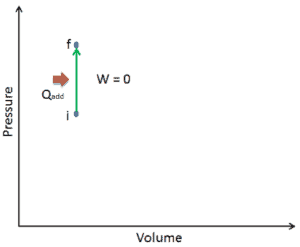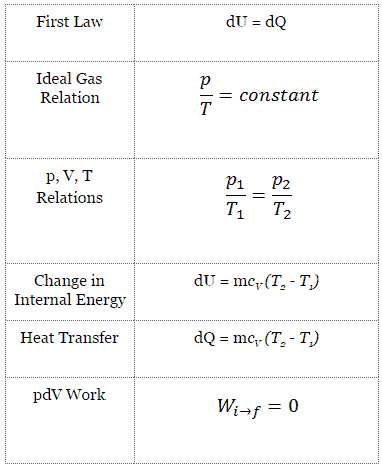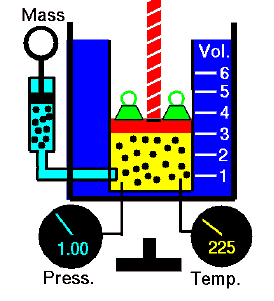Isochoric Process – Ideal Gas Equation
An isochoric process is a thermodynamic process, in which the volume of the closed system remains constant (V = const). It describes the behavior of gas inside the container, that cannot be deformed. Since the volume remains constant, the heat transfer into or out of the system does not the p∆V work, but only changes the internal energy (the temperature) of the system. For an ideal gas and a polytropic process, the case n ➝ ∞ corresponds to an isochoric (constant-volume) process.
See also: What is an Ideal Gas
 Let assume an isochoric heat addition in an ideal gas. In an ideal gas, molecules have no volume and do not interact. According to the ideal gas law, pressure varies linearly with temperature and quantity, and inversely with volume.
Let assume an isochoric heat addition in an ideal gas. In an ideal gas, molecules have no volume and do not interact. According to the ideal gas law, pressure varies linearly with temperature and quantity, and inversely with volume.
pV = nRT
where:
- p is the absolute pressure of the gas
- n is the amount of substance
- T is the absolute temperature
- V is the volume
- R is the ideal, or universal, gas constant, equal to the product of the Boltzmann constant and the Avogadro constant,
In this equation the symbol R is a constant called the universal gas constant that has the same value for all gases—namely, R = 8.31 J/mol K.
The isochoric process can be expressed with the ideal gas law as:
or
On a p-V diagram, the process occurs along a horizontal line that has the equation V = constant.
Pressure-volume work by the closed system is defined as:
Since the process is isochoric, dV = 0, the pressure-volume work is equal to zero. According to the ideal gas model, the internal energy can be calculated by:
∆U = m cv ∆T
where the property cv (J/mol K) is referred to as specific heat (or heat capacity) at a constant volume because under certain special conditions (constant volume) it relates the temperature change of a system to the amount of energy added by heat transfer.
Since there is no work done by or on the system, the first law of thermodynamics dictates ∆U = ∆Q. Therefore:
Q = m cv ∆T
See also: Specific Heat at Constant Volume and Constant Pressure
See also: Mayer’s formula
We hope, this article, Isochoric Process – Ideal Gas Equation – pV Diagram, helps you. If so, give us a like in the sidebar. Main purpose of this website is to help the public to learn some interesting and important information about thermal engineering.




